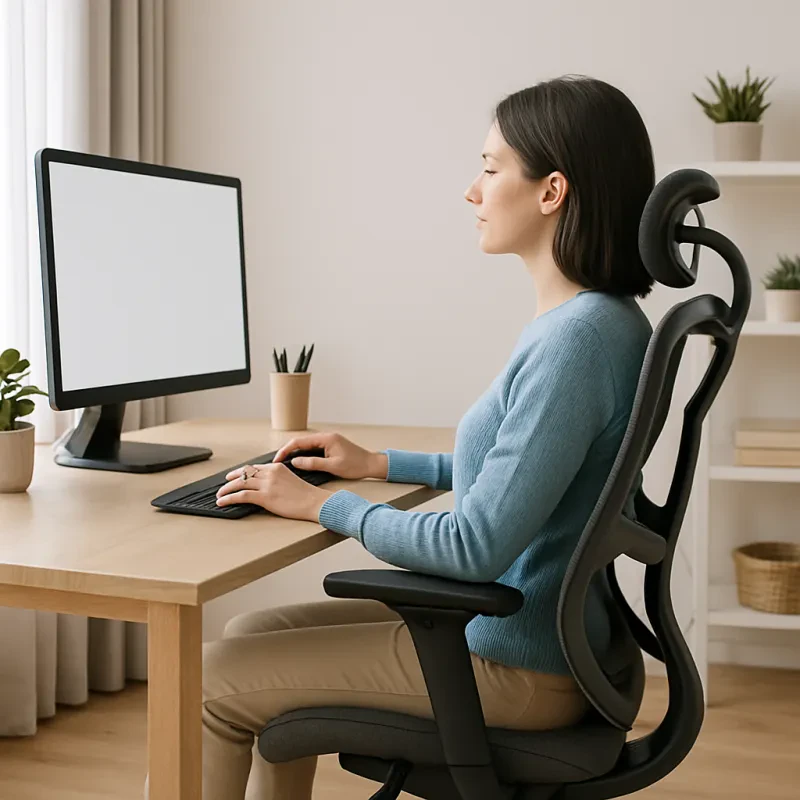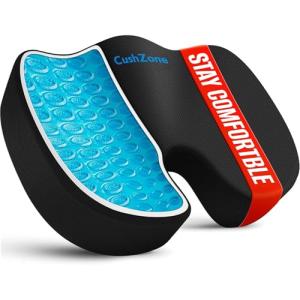Have you ever found yourself shifting uncomfortably in your chair after just a couple of hours at your desk? It's a common experience for many of us who spend long periods sitting, whether for work or leisure. What might surprise you is how something as simple as an ergonomic seat cushion can make a real difference not just in comfort, but in supporting your pelvic health and overall circulation. These cushions are designed with the body's natural structure in mind, helping to align your pelvis properly and promote better blood flow. In this article, we'll explore the physiological benefits of these cushions, focusing on how they aid pelvic alignment and enhance circulation. By understanding these advantages, you can make informed choices to improve your daily sitting experience.
Let's start by considering what happens to your body when you sit for extended times without proper support. In a typical chair, your weight presses down unevenly, often leading to a slouched posture where your pelvis tilts backward. This misalignment can strain the muscles and ligaments around your lower back and hips, potentially contributing to discomfort or even long-term issues. Ergonomic seat cushions address this by providing targeted support that encourages a more neutral pelvic position. For instance, cushions with a contoured design or forward tilt can help rotate your pelvis slightly forward, maintaining the natural curve of your lower spine, known as lumbar lordosis.
This improved alignment is crucial for pelvic health. When your pelvis is properly positioned, it reduces pressure on the pelvic floor muscles, which support organs like the bladder, intestines, and reproductive system. Studies have shown that cushions designed to promote anterior pelvic tilting—meaning a forward lean—can significantly enhance pelvic posture. In one research effort involving office workers, a specialized lumbo-pelvic cushion led to better anterior pelvic tilt and increased lumbar lordosis compared to sitting without any cushion. This adjustment not only helps prevent poor posture but also minimizes the risk of developing pain in the lower back area. Participants in the study reported reduced pain intensity after using the cushion, highlighting how proper alignment can alleviate strain on the pelvic region.
Beyond alignment, these cushions play a key role in supporting the pelvic organs themselves. Traditional seating can compress soft tissues in the pelvic area, which might affect organ function over time. Dynamic cushions, such as those with air-filled or foam-based structures, allow for subtle movements that distribute pressure more evenly. For example, saddle-style cushions with a central gap are particularly effective in reducing compression on the pudendal nerves and vessels in the pelvic floor. This design helps maintain healthy fluid pathways, which is especially beneficial for both men and women. In men, it can support prostate health by avoiding undue pressure that might lead to inflammation or enlargement. For women, it aids in reducing strain on the vulva and surrounding tissues, promoting overall genital health.
Now, let's turn to the circulation aspect, which is closely tied to pelvic alignment. Good blood flow is essential for delivering oxygen and nutrients to tissues while removing waste products. Prolonged sitting on hard or unsupportive surfaces can restrict circulation, leading to numbness, tingling, or even more serious issues like varicose veins or deep vein thrombosis if left unaddressed. Ergonomic cushions help counteract this by relieving pressure points on the buttocks, thighs, and lower back.
One of the primary ways cushions improve circulation is through better weight distribution. Foam seat cushions, for example, conform to your body's shape, spreading your weight across a larger area and reducing the force on any single point. This minimizes compression of blood vessels in the lower body, allowing for smoother blood flow to the pelvis, legs, and feet. Experts note that this can prevent the slowdown in metabolic function that occurs with restricted circulation, helping you feel less fatigued during long sitting sessions. In fact, by opening up the hips and lumbar region, these cushions can reduce symptoms like leg numbness, ensuring that blood circulates more freely.
Dynamic cushions take this a step further by encouraging movement while seated. Unlike static chairs, dynamic options—like those with a swinging mechanism or unstable base—prompt small postural shifts. These micro-movements activate muscles in the core and pelvis, which in turn stimulate blood flow. Research on dynamic chairs has demonstrated that they increase pelvic mobility, as measured by greater ranges of motion in lateral, vertical, and anteroposterior directions. This enhanced mobility not only reduces fatigue but also supports better circulation by preventing stagnation in the blood vessels. In a study with female workers performing desk tasks, those using a dynamic sitting balance chair experienced less post-work fatigue and improved pelvic flexibility compared to a standard office chair.
Moreover, these dynamic features can lead to measurable improvements in tissue health. For instance, air-filled dynamic cushions have been shown to increase subcutaneous oxygen saturation by about 2.2%, indicating better blood perfusion and tissue viability. This is particularly important for pelvic health, as improved oxygenation helps maintain the integrity of pelvic tissues and reduces the risk of discomfort or injury. The same study found that such cushions significantly lowered the incidence of low-back pain among high-risk office workers, with reductions up to 84%, by promoting these beneficial shifts in posture and pressure.
It's worth noting that not all cushions are created equal. Memory foam cushions excel in contouring to your body for personalized support, while gel-infused ones provide cooling effects that can further aid circulation by preventing heat buildup, which might otherwise constrict blood vessels. Wedge-shaped cushions with a forward slope are excellent for encouraging that anterior pelvic tilt we discussed earlier, making them ideal for desk setups. When choosing one, consider your specific needs—such as existing back issues or the type of chair you're using—to maximize the benefits.
Integrating an ergonomic cushion into your routine can also have broader health implications. By supporting pelvic alignment, you're helping to maintain the stability of your core, which influences everything from breathing to digestion. Proper alignment ensures that the pelvic floor muscles function optimally, potentially reducing risks associated with pelvic floor disorders. On the circulation front, consistent use can contribute to cardiovascular health by mitigating the negative effects of sedentary behavior. As health experts point out, sitting for too long without support increases risks for various conditions, but simple interventions like cushions can make a substantial difference.
Of course, while cushions are a great tool, they're most effective when combined with other habits. Taking short breaks to stand or walk, adjusting your workstation to ergonomic standards, and incorporating exercises that strengthen the pelvic floor can amplify these benefits. Think of the cushion as a foundational piece in your setup, working quietly in the background to keep your body aligned and your blood flowing smoothly.
In summary, ergonomic seat cushions offer tangible physiological advantages for pelvic health and circulation. They promote proper pelvic alignment by encouraging anterior tilting and maintaining lumbar lordosis, which reduces strain and supports organ function. At the same time, they enhance blood flow by distributing pressure evenly and allowing for dynamic movements that prevent vascular compression. Whether you're dealing with daily desk work or just want to sit more comfortably at home, investing in a quality cushion could be a small change with big rewards for your well-being.
References
-
Tanoue H, Nakashima A, Nakamura T, Nozawa Y. Effects of a dynamic chair on pelvic mobility, fatigue, and work efficiency during work performed while sitting: a comparison of dynamic sitting and static sitting. J Phys Ther Sci. 2016;28(6):1759-1763. doi:10.1589/jpts.28.1759. Available at: https://pmc.ncbi.nlm.nih.gov/articles/PMC4932051/
-
Sanjog J, Karmakar S. The effectiveness of a dynamic seat cushion in preventing neck and low-back pain among high-risk office workers: a 6-month cluster-randomized controlled trial. BMC Public Health. 2024;24(1):2263. doi:10.1186/s12889-024-19735-1. Available at: https://pmc.ncbi.nlm.nih.gov/articles/PMC11479679/
-
Mohamad N, Arifin N, Ibrahim R. Development of seat cushion to improve Lumbo-pelvic posture and pain in office workers. AIP Conference Proceedings. 2023;2685:040007. doi:10.1063/5.0112582. Available at: https://www.researchgate.net/publication/370566631_Development_of_seat_cushion_to_improve_Lumbo-pelvic_posture_and_pain_in_office_workers
-
The effect of different work chairs on pelvic organ health. Salli Saddle Chairs. Available at: https://salli.com/en/advanced-health-information/the-effect-of-different-work-chairs-on-pelvic-organ-health/
-
Why You Need a Foam Seat Cushion. Amerisleep. Published August 4, 2025. Available at: https://amerisleep.com/blog/why-you-need-a-foam-seat-cushion/







